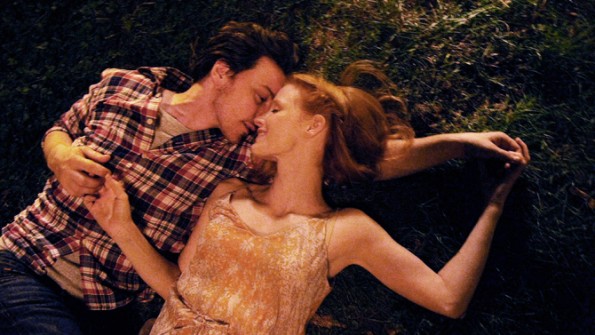The Disappearance of Eleanor Rigby: Him and Her (Benson, 2013)
Note: This review originally appeared at Christianity Today Movies & TV where it was part of the coverage of the 2013 Toronto International Film Festival. It is reprinted here since the films are now finally available via Netflix in the Him and Her format rather than as the composite Them version that played in most American theaters.
Clocking in at just over three hours, The Disappearance of Eleanor Rigby is really two movies played back to back. Him follows Conor (James McAvoy), a man trying to keep his failing restaurant afloat while he deals with his wife’s depression. When she leaves, he tries to wait patiently, tries to get on with his life, and fitfully tries to reconnect with her. Her follows Eleanor (Jessica Chastain) as she tries to deal with the root causes of her depression and start over after a family tragedy and a personal breakdown.
Eleanor Rigby‘s conceit—I’m tempted to say “gimmick”—is that it shows their two stories back to back rather than interweaving or cutting between them. Thus it becomes both a Rashomon story and a meditation on how we make and preserve memories. The films are designed to be played in either order, with one screening at TIFF flip-flopping to give us Her and Him.
I liked and esteemed the film a lot, even though the gimmick was the only part that didn’t work for me. After twenty-five years of marriage, I get that people remember things differently. And I appreciated in the film that some of the differences in the shared scenes were subtler than they often are in “he said/she said” situations.
Given that those shared scenes comprise maybe 15% of each narrative, however, it’s not so much that those scenes rendered more ambiguous, but that the others are destabilized. In literature, one can have a reliably unreliable narrator, but I didn’t see any stylistic indications that the scenes where the married couple is not alone are meant to be anything other than third-person omniscient. Thus the discrepancies between the shared scenes feels more like a cheat than an insight, as though the audience might not be able to restrain itself from taking sides even if it knew that what it knew was not the whole truth.
The film is at its best when some new piece of information illuminates and forces you to rethink what has happened before. Yet those moments are undercut with the small but persistent reminders that what is being illuminated might not have actually happened. Because, really, the difference between “didn’t happen that way” and “didn’t happen” is more than just self-justifying semantics, isn’t it?
I expect there will be people who like it even more than I. Some might accuse me of over-thinking it; some may be willing to out-overthink me. I found both individual stories compelling, and I actually wish the powers-that-be had the moxie to release them simultaneously as two separate movies. But barring all that, the Rashomon differences between the two narratives grated, but not enough to ruin the film. They pointed to emotional truth: we all see the world—including others’ behavior—through the interpretive lens of our own experience. If the film had allowed the characters to realize that for themselves and learn how to deal with that reality instead of being trapped in it, The Disappearance of Eleanor Rigby: Him and Her easily could have found a way on my end-of-year top ten list.

